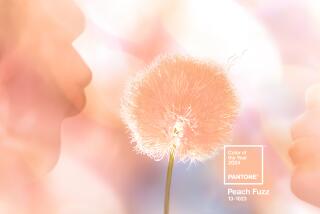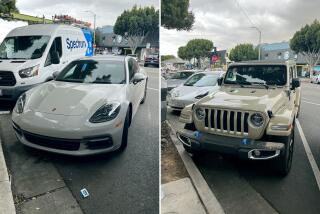The Palette Patrol
- Share via
It was the first day of the National Housewares Manufacturing Assn. show in Chicago in January, and Richard Ahern was nervous. The design manager for Rubbermaid’s home products division had, after a four-year campaign within his company, gotten the green light to produce his division’s product line in yellow. He had selected a shade dubbed Sunrise, a soft buttery yellow with red undertones. And Sunrise’s day had dawned.
There sat Rubbermaid’s waste baskets, dish drainers and laundry baskets for the buyers’ buyers to love or hate. It was the kind of gamble on which careers rise or fall. When the head buyer for Lechters, a national housewares chain, stopped by for a long look, Ahern’s personal color was closer to ash, until the buyer said, “This is by far the best new yellow I’ve seen and it will probably set the standard for the industry.”
At that moment, recalls Ahern, “I felt spectacular. I felt needed.”
Like any designer whose decisions put a lot of the company’s money on the line, Ahern worries. “My worst nightmare is that my company would mold millions of dollars in a product that no one would buy. I just make an educated guess. I don’t have a crystal ball.”
He does, however, have the next best thing: color forecasts, predictions by people who make it their business to know what colors you’re going to want two years before you do. Think of them as the Alan Greenspans of color, closely controlling the interest rates of hue.
Take that new lime green. You know, the shade all over the stores that makes most women (tan blonds aside) look as if they have perennial morning sickness? That was not some fluke, but rather the product of collusion. If the concept of color control seems Orwellian, rest assured: This mass manipulation has a bright side.
For one, the aim is to please consumers. “The buying public is constantly bombarded with color from television, movies, computers and marketing. As a result, they’re more receptive to and aware of color in all its nuances,” says Margaret Walch, associate director for the Color Assn. of the United States in New York, a leading forecasting group. Thus, to quote a current Target ad, they “Expect More Color.”
Walch points to cars as an example. Ten years ago, when you chose a car you had a choice of maybe five colors; today you have 10 or 12. The same is true of almost any manufactured product, she says.
To help them choose from the kaleidoscope of color, designers and manufacturers rely on forecasts. While forecasters can’t tell what will sell in a waste basket, a car or a blouse, they can accurately predict the direction color is moving and what will be coming on strong. They knew for example, two years ago that blue would be back, green would peak and white would eclipse black, which is all happening.
And they can tell you, the future of color is clear--as in less muddy. They are confident that the millennium will drive people toward brighter, more plentiful color, and that new technology is allowing breakthroughs that will put any color on any surface. They’re also seeing a democratization of color; that is, color trends no longer start in haute couture houses and trickle down, but come up from the streets. All this is making the demand for forecasting greater.
*
“These services are a tremendous help to designers because they give us focus,” says Michael Schrier, who designs fabrics and teaches at Otis College of Art and Design in Pasadena. “Because these people are studying only color and what’s influencing its movement, they help designers make color decisions with pertinent information.”
Christine Hershey, president of Hershey Associates, a Los Angeles-based graphic design firm, says that although the forecast is nice to have, “it doesn’t dominate what we do enough to be irritating. Sometimes it’s helpful to consider the forecast, then do the opposite intentionally just to stand out.”
She definitely relied on it, however, a few years ago when designing the palette for the New Mart, a downtown showroom for trendy apparel. “The owner prefers jewel tones, so she wasn’t initially thrilled when we showed her our choices derived from earth tones. Then I showed her how our colors corresponded with color projections . . . and that sold her.”
Along with the Color Assn., the other major player in the color cabal is the Color Marketing Group, of Arlington, Va. Twice a year these groups put out color palettes for fashion, commercial and residential interiors, graphics and the automotive industry. To be privy to this inside information, designers buy palettes from color services for more than $350, and more for customized palettes. Palettes are always two to three years in front of the market.
In apparel, for example, fabric designers need to know what colors will be in vogue so they can create the fabrics for clothing designers, who have to design clothes for their winter or spring runway shows, where store buyers make decisions six months before clothes get on store racks.
“Zillions of dollars ride on this,” as Schrier puts it. Unlike a weather forecast, which can be wrong, what’s predicted in the color world becomes self-fulfilling. Consumers see everything coming out in aqua and that suddenly feels very now.
Which begs the question: Is this color collaboration a mere ploy to stimulate consumption?
“Color equals sales,” Schrier says. “Although none of us needs anything in the way of clothes or furnishings, our desire to acquire new, fresh stuff is real. It’s market-driven and very much part of Western culture.”
Such color collaboration also fulfills people’s natural desire for change, Walch says. “People like change.” What’s more, because color researchers, designers and manufacturers are in cahoots, consumers can enjoy coordinated consumption.
As Melanie Wood, president of the Color Marketing Group, notes, if DuPont makes a paint and Mannington makes a carpet and Fieldcrest makes towels all in varying shades of the same hue, say Raging Cajun--a rust-like shade forecast to be big in 1998--then redecorating the bathroom just got easier.
CMG and the Color Assn. of the United States arrive at similar palettes in different ways. A nonprofit, international organization, CMG holds biannual conferences where 600 designers meet each with their own color forecast in hand. They present their palettes in small groups and eventually arrive at a conference consensus.
CAUS, which has been divining color trends since 1915, is a trade organization to which designers belong in order to receive color forecasts. The association has four committees that predict color trends in men’s, women’s and children’s fashion, and interiors.
*
Although a number of factors influence a designer’s reasons for choosing a particular palette, Walch says, the process is largely intuitive.
But they can rely on a few color constants. One, color cycles in a fairly predictable way. If a color has been on the market a long time, the color mavens will retire it for a while. Color also tends to run in decades. Strong saturated color and black dominated in the ‘80s, says Walch. “We had those hit-you-in-the-face colors like Nancy Reagan red, royal blue, strong purple. It was an era of exuberance and blatancy.”
More to Read
Inside the business of entertainment
The Wide Shot brings you news, analysis and insights on everything from streaming wars to production — and what it all means for the future.
You may occasionally receive promotional content from the Los Angeles Times.










